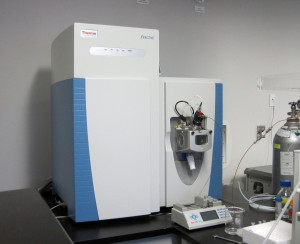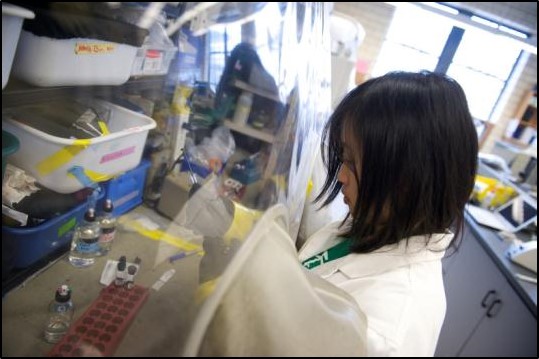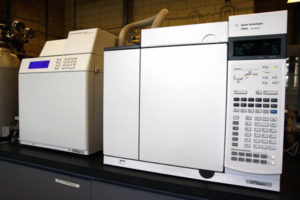BioZone is a focal point for bioengineering research at the University of Toronto.
Our facilities provide a collaborative space and cross-disciplinary approach that BioZone students and researchers to share knowledge, processes and equipment as they tackle difficult technical problems. The facility occupies the west wing of the 3rd and 4th floors of the Wallberg Building at the University of Toronto, providing over 1,800 m2 of laboratory and research workspace, including several large, bright, collaborative research labs.
BioZone's labs house a wide array of analytical instruments for molecular biology, protein purification and identification, enzyme kinetics, substrate and metabolite analysis, microscopy and cell growth.
Some BioZone analytical equipment is available for use by non-BioZone researchers. Please contact biozone@utoronto.ca for more details.
Featured Equipment
 The Bioanalytical and Mass Spectrometry facility expands the centre’s analytical capabilities for metabolomics and proteomics measurements and includes HPLC, UPLC, GC, nanoLC and nanoUPLC systems equipped with UV and mass spectrum detectors.
The Bioanalytical and Mass Spectrometry facility expands the centre’s analytical capabilities for metabolomics and proteomics measurements and includes HPLC, UPLC, GC, nanoLC and nanoUPLC systems equipped with UV and mass spectrum detectors.
- Exactive MS coupled to Accela 1250 pump and autosampler
- LTQ XL with EASY nLC / Proxeon
- Q Exactive (LC-MS)
- Varian Saturn 2100T GC/MS
- Mass Spec Facility Website
 BioZone houses a variety of bioreactors in a range of sizes for research into fermentation and biofiltration.
BioZone houses a variety of bioreactors in a range of sizes for research into fermentation and biofiltration.
- Infors HT Minifors (5L)
- Chemglass bioreactor (20L) , suitable for hydrolysis, fermentations or any other type of aqueous phase reaction at temperatures up to about 70ºC. Used to explore hydrolysis of biomass at high solids – 15 to 25%.
- Bench Scale Biofiltration System: continuous parallel bench scale bioreactors (app. 5 ft x 1 ft) for the study of biological gas cleaning. Their large size is suitable for testing various packing media. Gas and media sampling is possible for chemical, physical and microbial analysis. The system allows for introducing simulated air emissions with various air pollutants at controlled temperatures.
- Reduced Sulfur Biofiltration System: continuous biofiltration units for the study of the treatment of reduced sulphur pollutatnts such as hydrogen sulphide and dimethyl sulphide.
 The Quartz Crystal Microbalance (QCM) measures a mass variation on the a balance by measuring changes in frequency of a quartz crystal resonator. Since the frequency is disturbed by the addition or removal of a small mass or film deposition at the surface of the balance, the QCM can be used to measure the affinity of molecules (proteins in particular) to surfaces and how enzymes or other reactions affect the material coating the balance.
The Quartz Crystal Microbalance (QCM) measures a mass variation on the a balance by measuring changes in frequency of a quartz crystal resonator. Since the frequency is disturbed by the addition or removal of a small mass or film deposition at the surface of the balance, the QCM can be used to measure the affinity of molecules (proteins in particular) to surfaces and how enzymes or other reactions affect the material coating the balance.
Asymmetrical flow field-flow fractionation (AF4) is a fractionation method used for the characterization of nanoparticles, polymers and proteins. AF4 achieves separation of particles by applying a field to a fluid suspension pumped through a channel perpendicular to the direction of flow. Particles are separated depending on their differing “mobilities” under the force exerted by the field. AF4 works over a wide colloidal size range while maintaining high resolution
 X-ray diffractometers are used for the determination of the 3-dimensional structure of proteins. X-rays are focused onto the protein crystal of interest, which scatters the rays and produces a diffraction pattern. The position and intensity of the individual spots of the diffraction pattern are read by an imaging plate at the back of the diffractometer. These data are then used to determine the structure ie. the x, y, z co-ordinates of every (non-hydrogen) atom in the molecule.
X-ray diffractometers are used for the determination of the 3-dimensional structure of proteins. X-rays are focused onto the protein crystal of interest, which scatters the rays and produces a diffraction pattern. The position and intensity of the individual spots of the diffraction pattern are read by an imaging plate at the back of the diffractometer. These data are then used to determine the structure ie. the x, y, z co-ordinates of every (non-hydrogen) atom in the molecule.
1. Rigaku MICROMAX-007 x-ray generator with Rigaku R-axis 4++ image plate detector
2. Rigaku MICROMAX-007 x-ray generator with Rigaku HTC image plate detector
 The Thermo Fisher High-Performance liquid chromatograph (HPLC) with Diode Array Detector (DAD) and a Raytest Ramona Star Radioactivity Flow Detector (RFD) and Oxidizers can be used to track the transfer and transformation of radio-labelled contaminants and their degradation products for environmental and biological applications.
The Thermo Fisher High-Performance liquid chromatograph (HPLC) with Diode Array Detector (DAD) and a Raytest Ramona Star Radioactivity Flow Detector (RFD) and Oxidizers can be used to track the transfer and transformation of radio-labelled contaminants and their degradation products for environmental and biological applications.
 A wide range of centrifuges are available for a range of volumes from 1.5 mL to 1L.
A wide range of centrifuges are available for a range of volumes from 1.5 mL to 1L.
1. OptimaTM L-90K ultracentrifuge (Beckman Coulter)
2. Avanti J-E high-speed centrifuge (Beckman Coulter)
3. Allegra centrifuge, including a swinging bucket rotor and plate adapter (Beckman Coulter)
4. Biofuge fresco microcentrifuge (Sorvall)
5. DNA 120-115 speed vac (Thermo Electron Corp)
6. Avanti J-E 251 high-performance centrifuges (Beckman Coulter)
 BioZone houses both upright and inverted microscopes that can take bright field and fluorescence images. The automated microscope also has a stage top incubator to allow imaging of cells during cell culture at 37 oC for up to 5 days. Furthermore, the automated microscope has a fully motorized stage allowing image stitching of images from adjacent fields of view. Micro- scopes are equipped with 4X, 10X, 20X, 40X, 63X and 100X lenses. In addition, the Image Express Micro is a high content screening microscope with environmental control. Images can be automatically collected in multiple locations within multiple wells of a well plate over time under conditions that allow cells to culture. Both bright field images and fluorescence im- ages can be collected. The specific microscope models are:
BioZone houses both upright and inverted microscopes that can take bright field and fluorescence images. The automated microscope also has a stage top incubator to allow imaging of cells during cell culture at 37 oC for up to 5 days. Furthermore, the automated microscope has a fully motorized stage allowing image stitching of images from adjacent fields of view. Micro- scopes are equipped with 4X, 10X, 20X, 40X, 63X and 100X lenses. In addition, the Image Express Micro is a high content screening microscope with environmental control. Images can be automatically collected in multiple locations within multiple wells of a well plate over time under conditions that allow cells to culture. Both bright field images and fluorescence im- ages can be collected. The specific microscope models are:
- Olympus CKX1 live cell inverted microscope
- Olympus 120Q live cell inverted microscope
- Olympus BX51 microscope
- Leitz Laborlux S microscope
- Molecular Devices Image Xpress Micro Widefield High Content Screening System
Examples of current projects in the BioZone that utilize the microscope facility include quantifying the alignment response of airway epithelial cells cultured on substrates contain- ing guidance signals, characterizing the cooperative behaviour of epithelial cells re-organizing in confluent 2D monolayer sheets, assessing cellular invasion of cancer cells into sur- rounding stromal tissues in 3D, and real-time monitoring of engineered tumour growth in response to drug treatments.
 This machine allows glass and PDMS substrates to be cleaned with air plasma. This plasma treatment produces surface chemistry alterations of the PDMS and glass to enable easier bonding of the two surfaces for generating microfluidic devices and for altering the surface wettability of the materials for cell culture.
This machine allows glass and PDMS substrates to be cleaned with air plasma. This plasma treatment produces surface chemistry alterations of the PDMS and glass to enable easier bonding of the two surfaces for generating microfluidic devices and for altering the surface wettability of the materials for cell culture.
- AM Harrick Plasma














